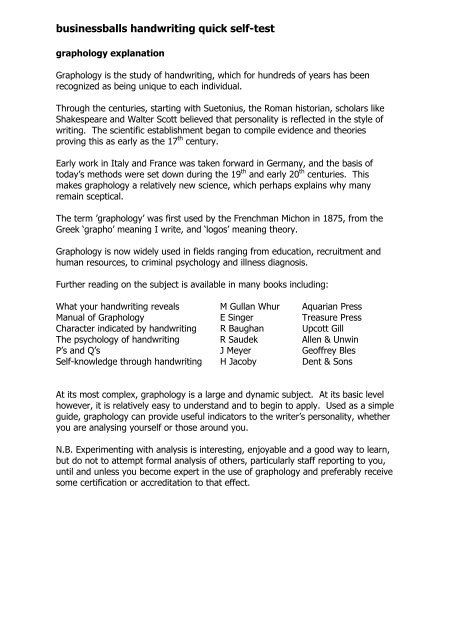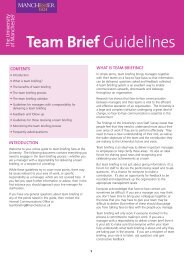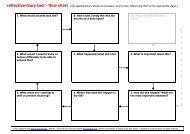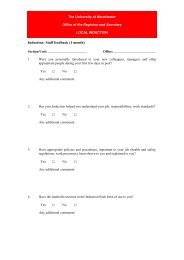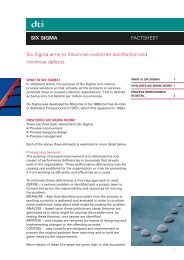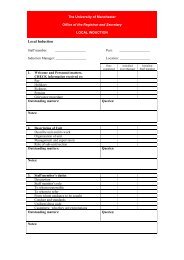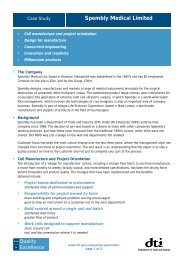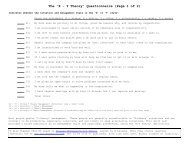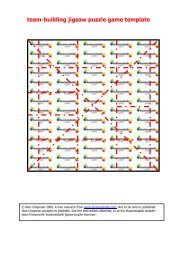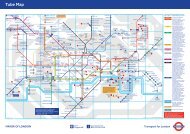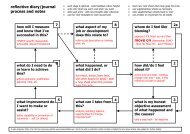businessballs handwriting quick self-test
businessballs handwriting quick self-test
businessballs handwriting quick self-test
You also want an ePaper? Increase the reach of your titles
YUMPU automatically turns print PDFs into web optimized ePapers that Google loves.
usinessballs <strong>handwriting</strong> <strong>quick</strong> <strong>self</strong>-<strong>test</strong><br />
graphology explanation<br />
Graphology is the study of <strong>handwriting</strong>, which for hundreds of years has been<br />
recognized as being unique to each individual.<br />
Through the centuries, starting with Suetonius, the Roman historian, scholars like<br />
Shakespeare and Walter Scott believed that personality is reflected in the style of<br />
writing. The scientific establishment began to compile evidence and theories<br />
proving this as early as the 17 th century.<br />
Early work in Italy and France was taken forward in Germany, and the basis of<br />
today’s methods were set down during the 19 th and early 20 th centuries. This<br />
makes graphology a relatively new science, which perhaps explains why many<br />
remain sceptical.<br />
The term ’graphology’ was first used by the Frenchman Michon in 1875, from the<br />
Greek ‘grapho’ meaning I write, and ‘logos’ meaning theory.<br />
Graphology is now widely used in fields ranging from education, recruitment and<br />
human resources, to criminal psychology and illness diagnosis.<br />
Further reading on the subject is available in many books including:<br />
What your <strong>handwriting</strong> reveals M Gullan Whur Aquarian Press<br />
Manual of Graphology E Singer Treasure Press<br />
Character indicated by <strong>handwriting</strong> R Baughan Upcott Gill<br />
The psychology of <strong>handwriting</strong> R Saudek Allen & Unwin<br />
P’s and Q’s J Meyer Geoffrey Bles<br />
Self-knowledge through <strong>handwriting</strong> H Jacoby Dent & Sons<br />
At its most complex, graphology is a large and dynamic subject. At its basic level<br />
however, it is relatively easy to understand and to begin to apply. Used as a simple<br />
guide, graphology can provide useful indicators to the writer’s personality, whether<br />
you are analysing your<strong>self</strong> or those around you.<br />
N.B. Experimenting with analysis is interesting, enjoyable and a good way to learn,<br />
but do not to attempt formal analysis of others, particularly staff reporting to you,<br />
until and unless you become expert in the use of graphology and preferably receive<br />
some certification or accreditation to that effect.
the basic features of <strong>handwriting</strong><br />
Write a few sentences freely on a level surface in the space provided.<br />
Now look for and be able to identify the main features of the writing above:<br />
• Size and proportions<br />
• General layout<br />
• Direction of lines<br />
• Degree of connection<br />
• Regularity<br />
• Rhythm (or evenness)<br />
• Degree of broadness<br />
• Speed of writing<br />
• Form of letters<br />
• Covering of space<br />
• Shading<br />
• Angle of writing (slope)<br />
• Right and left tendencies<br />
• Spacing<br />
• Degree of attention<br />
• Pressure<br />
• Decoration/distortion<br />
Now follow the basic analysis process below, which you can use on other samples.<br />
The more you practice, the you become able to analyse without referring to the<br />
written guidelines:
graphology - the basic analysis<br />
is the sample valid That is, has the style of the writing been affected by any<br />
external influences Eg., an uneven writing surface; an awkward writing position;<br />
or written on the move (in a car or train, etc.). You cannot analyse a sample that is<br />
not reliable. For the purpose of checking slope and coverage it is more difficult to<br />
analyse samples that have been written on lined paper.<br />
size - There are many aspects to the size of writing and alone it doesn’t indicate<br />
many things. Size (and especially the relative size of letter parts) needs to be<br />
considered along with other factors. There are some simple indicators however.<br />
Small writing is generally a strong indicator of a detailed, technical personality.<br />
Large rounded and dominant central case (see the later explanation of ‘cases’)<br />
letters indicate a friendly and sociable personality.<br />
letter-word slope - Is there a consistent slope to the letters and therefore the<br />
words in the sample Check by drawing lines through the up and downward<br />
strokes. Backwards slopes indicate an introverted personality; forward slopes are<br />
extraverted. Upright strokes indicate a personality who is motivated by factors<br />
other than people, (ie neither extrovert nor introvert). The degree of slope reflects<br />
the degree of extraversion or introversion. The degree of consistency of the slope<br />
(ie parallel strokes) indicates the degree of emotional consistency.<br />
line slope - Writing which rises to the right shows optimism and cheerfulness.<br />
Sagging to the right shows physical or mental weariness. (This applies to<br />
signatures sloping-downwards also.)<br />
flow - One of the essential indicators, but like any other factor not to be used on<br />
its own. Generally, restraint is indicated every time the pen leaves the paper, and<br />
the converse applies. Gushing, eager, impulsive people have a more continuous<br />
flow of writing. Flowing writing has linked letters and sometimes linked words.<br />
Thoughtful, considered people will have fewer linked letters and no linked words.<br />
Artistic and conceptual people who like space and time around them will often have<br />
completely separated letters. (It follows that pressure at school on some children to<br />
‘write joined-up’ - because the common view is that to do otherwise is ‘not grownup’<br />
- is unnatural and often counter-productive. In any event continuity of flow does<br />
not correlate to intelligence.)<br />
spacing - Space between words indicates social attitude to others. Close words<br />
are a sign of sociability. Large spaces between words indicate the person is<br />
comfortable alone, and may even distrust others. Spacing between letters shows<br />
artistic spatially aware character, (artists, etc.)<br />
decoration and distortion - Don’t confuse the two. Decoration is intended;<br />
distorted is malformed and unintentional. Both are different to unfinished letters,<br />
which is a different indicator. Decoration is generally a sign that the writer wishes<br />
to be noticed more than he or she is at present. Malformed letters indicate a<br />
variety of things which must be dealt with individually. Unfinished words can be a<br />
sign of intelligence and impatience.
the three cases - divisions of the personality<br />
An essential aspect to analyse is the bias of the writing towards upper, central and<br />
lower cases. The upper case is the area in which the extended up-strokes are found<br />
in the tall letters like b, d, f, h, l, t, etc. The central or middle case is the central<br />
region occupied by letters with neither long up-strokes nor long down-strokes, such<br />
as a, c, e, m, n, o, etc. Which obviously means that the lower case is the area<br />
occupied by the extended down-strokes of letters such as g, j, p, q, etc.<br />
Idealism<br />
religion<br />
philosophy<br />
imagination<br />
logic<br />
pragmatism<br />
common-sense<br />
instinct<br />
animal appetite<br />
physical force<br />
upper<br />
central<br />
lower<br />
The central case contains most of the writing. The upper and lower cases are those<br />
which extend above and below the central body of each letter. The three cases<br />
represent the three aspects of our personality. If it helps you to assess the relative<br />
dominance of the three cases draw a horizontal set of ‘tram-lines’ through some<br />
lines of writing to mark the division between the three cases. Look at the relative<br />
dominance and extent of each of the cases.<br />
Upper<br />
Central<br />
Lower<br />
our ‘higher’ selves, and thinking about religion and philosophy<br />
our mental and social approach to life<br />
our physical aptitudes and attitudes<br />
Look where the writing is mainly concentrated, and where the emphasis is; this is<br />
where the emphasis of the personality is too. Look for any encroachment from<br />
upper case to the line above or from lower case to the line below - it’s a sure<br />
indication that the encroaching case is dominant. Also look at the central case to<br />
see if there is an upward or downward pull. An upward pull is best spotted if you<br />
see an arched pattern running through the central case. A downward pull is best<br />
spotted by seeing a pattern of troughs through the central case. The pull pattern in<br />
the central case also indicates the emphasis of the personality.
some other simple indicators<br />
• Large broad upper loops are a sign of emotion.<br />
• Right-pulled lower loops show interest for the good of others.<br />
• Left-pulled upper case shows a fondness for the past.<br />
• Uneven upper loops show changeable satisfaction, or disillusionment.<br />
• Full left-pulled lower loops show physical fulfilment.<br />
• Closed ‘e’s and other small closed central loops show secrecy.<br />
• ‘Stand-alone’ or properly formed ‘s’s at word ends show independence.<br />
• Word-end ‘s’s where top of letter is formed into downward right loop show a<br />
yielding or co-operative nature.<br />
• Angular central case is a sign of an interest in ideas rather than people.<br />
• Rounded central case shows interest in people.<br />
• Uncompleted case letters, eg ‘a’s, ‘b’s etc., (open when they would normally be<br />
joined loops) show a casual nature; very open shows propensity to gossip.<br />
• Small writing is generally a sign of technical personality.<br />
• Loops in angular writing show a potentially difficult character.<br />
• ‘T’ cross strokes connecting a number of ‘t’s with a single line shows speed of<br />
thought (but not a guarantee of correct thinking).<br />
• Omitted ‘i’ dots and ‘t’ cross strokes shows forgetfulness or carelessness.<br />
• Position and style of ‘i’ dots show different things:<br />
Directly above, close to and in line means exacting.<br />
Ahead means active and thinking.<br />
Flicked shows sense of humour.<br />
Behind shows thoughtful.<br />
Inconsistent (varying positions) means a distracted mind.<br />
and in general - You should try to build up a picture of the person you are<br />
analysing using as many different indicators as possible. Also try to use other<br />
psychometric <strong>test</strong>s and systems to build up a multi-dimensional picture; the more<br />
perspectives you can use the better.<br />
If this brief introduction interests you then get hold of a book or two on the subject<br />
and teach your<strong>self</strong> more. It’s a fascinating subject and a useful additional way of<br />
providing insight into your own personality and those around you.<br />
This tool was developed by alan chapman consultancy and you may use it personally or within your organisation provided<br />
copyright and www.<strong>businessballs</strong>.com is acknowledged. Publication in any form or use in provision of business services to a<br />
third party is not allowed without permission from alan chapman. Support and advice on using this system is available from<br />
alan chapman via email advice@alanchapman.com. More free online training resources are at www.<strong>businessballs</strong>.com.<br />
© alan chapman 2002. www.<strong>businessballs</strong>.com


